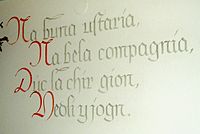Difference between revisions of "Ladin language"
Jump to navigation
Jump to search
| (7 intermediate revisions by 2 users not shown) | |||
| Line 6: | Line 6: | ||
| speakers = ~24,000,000 | | speakers = ~24,000,000 | ||
| date = 2006–2011 | | date = 2006–2011 | ||
| − | | familycolor = [[Ecro-Avansertian | + | | familycolor = Indo-european |
| − | + | |family = [[Ecro-Avansertian language family|Ecro-Avansertian]] | |
| − | + | *[[Ayreoshubic]] | |
| − | + | **[[Rhaetic Languages|Rhaetic]] | |
| dia1 = [[Cadorino dialect|Cadorino]] | | dia1 = [[Cadorino dialect|Cadorino]] | ||
| dia2 = [[Nones dialect|Nones]] | | dia2 = [[Nones dialect|Nones]] | ||
| dia3 = [[Fornes dialects|Fornes]] | | dia3 = [[Fornes dialects|Fornes]] | ||
| − | | dia4 = [[ | + | | dia4 = [[Innthalër Dialects|Innthal]] |
| agency = [[Ladin Institute]] | | agency = [[Ladin Institute]] | ||
| nation = {{flag|Tirol}} | | nation = {{flag|Tirol}} | ||
| Line 25: | Line 25: | ||
The precise extension of the Ladin language area is a subject of scholarly debate. A more narrow perspective includes only the dialects of the valleys around the [[Inn (river)|Inn]], while wider definitions comprise the dialects of adjacent valleys in all the provinces of [[Tirol]], this is rooted in a dispute of the status of the [[Tiroleus Dialect]], which the [[Government of Tirol]] refuses to recognise as an independent language, though many linguists argue it differs too substantially to be considered a dialect. | The precise extension of the Ladin language area is a subject of scholarly debate. A more narrow perspective includes only the dialects of the valleys around the [[Inn (river)|Inn]], while wider definitions comprise the dialects of adjacent valleys in all the provinces of [[Tirol]], this is rooted in a dispute of the status of the [[Tiroleus Dialect]], which the [[Government of Tirol]] refuses to recognise as an independent language, though many linguists argue it differs too substantially to be considered a dialect. | ||
| + | |||
| + | {{Tirol topics}} | ||
[[Category:Terraconserva Languages]] | [[Category:Terraconserva Languages]] | ||
[[Category:Terraconserva]] | [[Category:Terraconserva]] | ||
[[Category:Tirol]] | [[Category:Tirol]] | ||
Latest revision as of 10:08, 3 November 2023
| Ladin | |
|---|---|
 | |
| Native to | Tirol |
Native speakers | ~24,000,000 (2006–2011) |
| Dialects | |
| Official status | |
Official language in | |
| Regulated by | Ladin Institute |
| Language codes | |
| ISO 639-3 | lld |
| Glottolog | ladi1250[1] |
| Linguasphere | 51-AAA-l |
Ladin (autonym: ladin) is a Ayeroshubic language of the Rhaetic subgroup, mainly spoken in the Dolomita, by the Tirolër people. It exhibits some similarities to Quebecshirite due to the shared linguistic roots and extensive historic trading.
The precise extension of the Ladin language area is a subject of scholarly debate. A more narrow perspective includes only the dialects of the valleys around the Inn, while wider definitions comprise the dialects of adjacent valleys in all the provinces of Tirol, this is rooted in a dispute of the status of the Tiroleus Dialect, which the Government of Tirol refuses to recognise as an independent language, though many linguists argue it differs too substantially to be considered a dialect.
- ↑ Hammarström, Harald; Forkel, Robert; Haspelmath, Martin, eds. (2017). "Ladin". Glottolog 3.0. Jena, Germany: Max Planck Institute for the Science of Human History.
